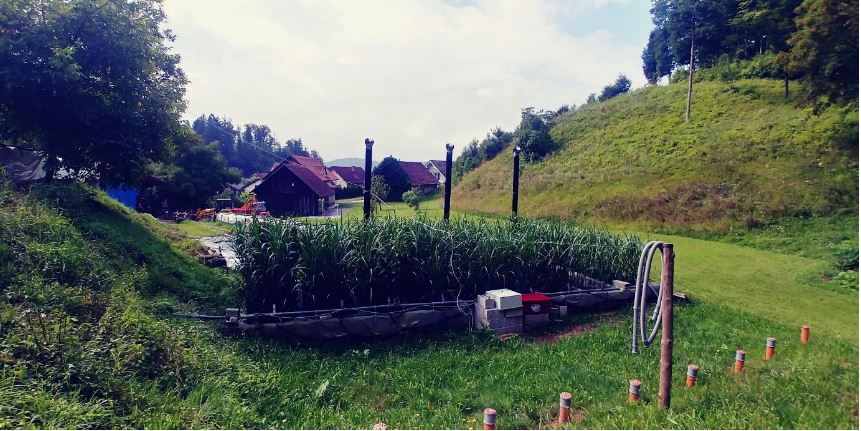
Resarch site
Basic idea behind the presented project, financed by RS Ministry of Education, Science and Sport with EU European Fund for Regional Development, was to investigate how additional aeration to the zone where biochemical processes occur could enhance sludge decomposition process. In order to achieve more aerobic condition a passive aeration, consisted of so-called chimney and active aeration, where air was added through air blower, were constructed as mesocosm experiment. For comparison third treatment with no aeration (control) was also set. All beds were planted with Miscanthus plants (Miscanthus x giganteus), a perennial C4 grass. As mentioned, STRBs are planted with the common reed (Phragmites australis), a C3 wetland grass. In this case, Miscanthus was selected for its specific C4 carbon isotope signature, which allowed us to study different contributions to soil CO2 efflux.

Schematic picture of experiment
To determine the characteristics of each treatment many abiotic factors, such as continuous measurements of O2 and CO2 concentrations and temperature were measured in each bed. Besides weather station with ability to measure wind speed, environmental temperature and precipitation rate were established.
To assess sludge decomposition rates decomposition bags were used to directly determine the possible effects of additional air supply to the system. Decomposition bags were filled with dried sludge and inserted into sludge residue in STRBs. After certain period bags were removed and dried. The loss of the mass from the begs can be assigned to the decomposition process. Measurements of CO2 emissions (CO2 efflux) from the beds were made to gain a better insight into the instantaneous decomposition rate. The CO2 efflux from the STRBs (CO2 STRB) consists of two sources: i) sludge-derived CO2 from sludge decomposition (CO2 sludge) and ii) plant-derived CO2 produced from Miscanthus root respiration or decomposition of organic matter derived from Miscanthus (CO2 misc). In order to investigate the contributions of CO2 sludge and CO2 misc to CO2 STRB, a stable isotope analysis of the CO2 emitting from the STRBs (δ13CSTRB) was carried out several times.
This study showed that artificial aeration of STRBs significantly increases the O2 concentration in the upper part of the filter layer during the first 1.5 years of operation. In this respect, passive aeration was similarly efficient to active aeration. Some data, e.g. measurement of decomposition and isotopic composition of CO2 efflux, indicated an accelerated sludge decomposition process in aerated beds (A and P), which was confirmed by the continuous decomposition process in the A and P beds even after a one-year period when the majority of easily decomposed substances had already been consumed by microbes. However, other measurements revealed that this effect was limited to part of the season and could not be demonstrated by episodic measurxements of CO2 effluxes.